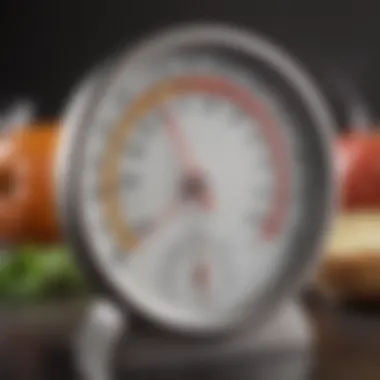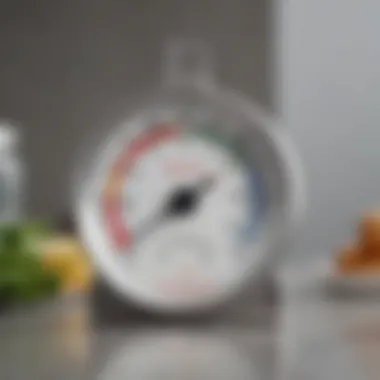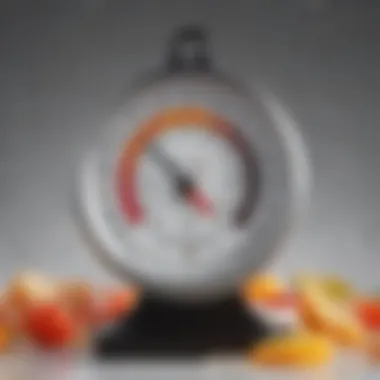Explore the Best Leave-in Cooking Thermometers


Intro
Leave-in cooking thermometers are critical tools for anyone serious about cooking. They allow for precise temperature measurement without the need to constantly open an oven or smoker. This functionality helps maintain steady cooking conditions, ensuring that dishes reach the perfect doneness.
Whether you are an experienced chef or a curious home cook, understanding the nuances of these thermometers can significantly elevate your culinary methods. This guide will explore the different types of leave-in cooking thermometers, their essential features, and practical usage tips to help you find the best one suited for your kitchen needs.
The relevance of accurate temperature measurement cannot be understated. It plays a vital role in food safety, as well as in achieving the flavors and textures desired in gourmet dishes. Cooking meat, for instance, to the correct internal temperature is crucial to prevent foodborne illnesses, while also ensuring the meat is tender and flavorful. As we proceed, we will explore the key aspects of leave-in cooking thermometers, diving into how they enhance the cooking experience and prevent common mistakes.
Foreword to Leave-in Cooking Thermometers
In culinary pursuits, understanding temperature control is crucial. The use of leave-in cooking thermometers significantly enhances one’s ability to prepare dishes accurately. These devices help chefs monitor the internal temperature of food throughout the cooking process, ensuring that meats are cooked safely and other dishes achieve their intended textures. The relevance of this topic lies in its impact on cooking outcomes, making it essential for both novice and seasoned cooks alike.
Accurate temperature measurement serves not just to ensure safety but also elevates the quality of the food. Undercooking can pose health risks, while overcooking leads to loss of flavor and moisture. Hence, investing time in understanding what leave-in cooking thermometers are and their importance fosters better culinary skills and knowledge.
What is a Leave-in Cooking Thermometer?
A leave-in cooking thermometer is an instrument designed to be placed in food while it cooks. Unlike traditional thermometers, which require the cook to periodically check the temperature, leave-in thermometers stay in the food throughout the cooking process. This allows for real-time temperature monitoring without disrupting the cooking cycle.
Most models come equipped with a temperature probe and a display unit. The probe is inserted into the food, while the display unit shows the ongoing temperature readings. This design is particularly advantageous for larger cuts of meat or dishes that require long cooking times, such as roasts or stews. The primary purpose is to ensure that food reaches the desired internal temperature, which can vary by dish.
The Importance of Accurate Temperature Control in Cooking
Precise temperature control is one of the foundational elements in cooking. Many culinary techniques hinge on achieving specific temperatures to unlock desired flavors and textures. For instance, the Maillard reaction, which gives browned foods their distinctive flavor, occurs at an optimal temperature range. Failing to reach this temperature can lead to lackluster food.
Moreover, accurate temperature measurement guarantees food safety. Cooking meat, for example, to the correct internal temperature destroys harmful bacteria, thus preventing foodborne illness. This critical aspect underscores why a leave-in cooking thermometer is an indispensable tool in the kitchen.
Accurate temperature control inherently impacts the outcome of your dishes, leading to safer and tastier meals.
In summary, mastering the use of leave-in cooking thermometers is essential for any cook aiming for excellence. Their role in ensuring both safety and culinary quality cannot be overstated.
Types of Leave-in Cooking Thermometers
Understanding the types of leave-in cooking thermometers is crucial for making informed choices. Each type offers unique features that cater to different cooking styles and preferences. By knowing the differences, cooks can select the right thermometer that fits their needs, which enhances the cooking experience and overall results.
Digital Thermometers
Digital thermometers are popular for their speed and accuracy. They typically use a probe to measure the internal temperature of food. The digital display provides real-time readings, often within seconds. This immediacy is valuable when cooking proteins like poultry or beef, where precise temperatures are important for food safety and taste.
Key features of digital thermometers include:
- Fast readouts: Many models give readings in under 10 seconds.
- Temperature alerts: Some devices can be set to notify users when the desired temperature is reached, preventing overcooking.
- Multiple probes: Higher-end digital thermometers may come with multiple probes, allowing for simultaneous monitoring of different dishes.
In summary, for cooks who prioritize efficiency and precision, digital thermometers represent a solid choice.
Analog Thermometers
Analog thermometers, also known as dial thermometers, have been a staple in kitchens for many years. They feature a simple design consisting of a metal probe connected to a dial display. While they may not read as quickly as digital models, analog thermometers are durable and can be quite accurate if calibrated properly.
Advantages of analog thermometers include:
- No batteries needed: They operate without power, making them reliable in various settings.
- Visual feedback: The dial display can be easier to read at a glance in some cooking situations.
- Affordability: Generally, analog models tend to be less expensive, making them accessible for home cooks.
Despite the slower response time, analog thermometers appeal to traditionalists and those who enjoy a straightforward tool.
Smart Thermometers
Smart thermometers utilize modern technology to enhance the cooking process. These devices often connect to smartphones via Bluetooth or Wi-Fi, allowing users to monitor their cooking from a distance. With smart thermometers, temperature control becomes more convenient, especially for multitasking cooks.


Smart thermometer features often include:
- Mobile app integration: Users can set targets and receive notifications on their devices.
- Cloud functionality: Some models store cooking data, which can be analyzed for future reference.
- Customizable settings: Advanced options allow cooks to tailor alerts and track temperature over time.
For tech-savvy cooks or those who frequently prepare complex dishes, smart thermometers can be transformative tools in the kitchen.
Key Features to Consider
When selecting a leave-in cooking thermometer, several key features play a significant role in ensuring a successful cooking experience. Understanding these features can guide both novice cooks and seasoned chefs in making informed decisions. The right thermometer provides not just accuracy but also convenience and usability, which are essential for achieving optimal cooking results.
Temperature Range and Accuracy
The temperature range of a leave-in cooking thermometer is crucial. Different types of meats and dishes require specific cooking temperatures for safety and quality. For instance, poultry needs to reach an internal temperature of 165°F (75°C), while beef medium-rare is best at 130°F (54°C).
Accuracy goes hand in hand with temperature range. A thermometer that shows a temperature but is off by a few degrees can lead to undercooked or overcooked food. High-quality thermometers typically offer an accuracy of ±1°F (±0.5°C). When shopping, look for models that advertise precision in their specifications. Reliable accuracy helps in maintaining safety standards and enhancing flavor.
Probe Length and Materials
Probe length affects how you can position the thermometer in your food. Longer probes allow for deep insertion into larger cuts of meat, ensuring that the internal temperature is measured correctly. Look for probes that provide a length of at least 5 inches for versatility.
Material matters too. Stainless steel probes are common due to their durability and resistance to corrosion. They can withstand high temperatures and are easier to clean. Some thermometers also feature heat-resistant plastic handles, which are useful in preventing burns. Be mindful of these materials, as they influence both performance and maintenance.
Display Type and User Interface
The display type of a thermometer impacts how easily you can read the temperature. Some thermometers feature digital displays, which can include backlighting for use in darker environments. Clear and large displays make for fast readings, reducing the guesswork in timing your food.
User interfaces should also be intuitive. A simple button setup that allows you to toggle through different modes (like Celsius and Fahrenheit) can enhance the user experience. Basic thermometers might only have one function, but more advanced models offer programmable settings for specific meats and cooking styles. With a user-friendly interface, users can focus more on cooking rather than fussing with the device.
Connectivity Features
Modern cooking thermometers may also include connectivity features. Bluetooth and Wi-Fi capabilities enable the thermometer to communicate with your smartphone or tablet. This allows for real-time monitoring of cooking temperatures without needing to be physically present at the cooking site.
Some devices offer mobile apps that can alert you when your food has reached the desired temperature. These features save time and provide convenience, especially during complex cooking processes that demand attention to multiple elements simultaneously. They also enhance overall cooking control, ensuring that perfection can be achieved every time.
"Investing in a quality leave-in cooking thermometer is essential for anyone serious about cooking and food safety."
Each of these features contributes to a better cooking experience. When you evaluate leave-in cooking thermometers, think carefully about your individual needs. Whether you cook frequently or occasionally, choosing the right model can make a noticeable difference in your culinary outcomes.
Top Recommendations in Leave-in Cooking Thermometers
In discerning the right leave-in cooking thermometer, the variety of options available might seem overwhelming. Therefore, it becomes crucial to highlight recommendations that stand out for both performance and reliability. Selecting a thermometer based on its functionality, budget constraints, and cooking needs can make a notable difference in the culinary experience. These recommendations are based on thorough reviews, user feedback, and empirical testing, making them suitable choices for different types of cooks.
Best Overall Leave-in Cooking Thermometer
The ThermoWorks ChefAlarm takes the lead as the best overall leave-in cooking thermometer. Its temperature range spans from -58°F to 572°F, providing versatility for various cooking methods, from low and slow to high-heat searing. It possesses precision of ±1°F which is essential for serious cooks aiming for perfect results. The robust build and easy-to-read display make it user-friendly. It features a programmable alert for optimal doneness and a hold feature for quick reads, which adds considerable value during cooking.
Best Budget Option
If you are seeking quality without breaking the bank, the ThermoPro TP16 is an excellent choice. This digital thermometer offers an affordable price point while not compromising accuracy. It can measure temperatures from -58°F to 572°F and has a clear LCD display. It also includes pre-programmed temperatures for different meats, simplifying the cooking process. Many users appreciate its ease of setup and reliability, making it an ideal option for beginners who wish to improve their cooking.
Best for Advanced Home Cooks
For those who enjoy mastering culinary techniques, the Maverick ET-733 is a superb tool. This dual-probe thermometer connects via wireless technology, allowing cooks to monitor multiple items simultaneously from a distance. It has a wide temperature range, from 32°F to 572°F, and is ideal for advanced techniques such as smoking meats. The probe's construction ensures durability and a reliable reading. Many find that the ability to cook while monitoring from afar transforms the cooking experience.
Best Smart Thermometer
Finally, the Meater Plus occupies the top spot for smart thermometers. This wireless unit utilizes Bluetooth connectivity and a free app to monitor meat doneness accurately. It features a dual sensor probe that measures internal and ambient temperature, enhancing its cooking capabilities. It also provides estimated cooking times, ensuring the cook stays informed without constant checking. The Meater Plus is well-regarded for its convenience and ease of use, aligning perfectly with tech-savvy home chefs.


Key Point: Choosing the right leave-in cooking thermometer can significantly affect the quality of your dishes. Assess your needs, preferences, and budget to make the most informed decision.
How to Use a Leave-in Cooking Thermometer
Understanding the proper techniques for using a leave-in cooking thermometer is essential for achieving culinary success. This section highlights critical elements, benefits, and considerations that ensure effective measurement of cooking temperatures, which is vital for food safety and quality. An accurate thermometer assists in attaining desired doneness without needing to disrupt the cooking process. It lets you attend to other tasks while monitoring temperature, all while enhancing meal consistency.
Setting Up the Thermometer
To start, setting up your leave-in thermometer correctly is fundamental. Each model may have specific instructions, but some general steps apply universally. First, ensure that your thermometer is clean and in good condition. Next, insert the probe into the thickest part of the food, avoiding any bone, fat, or gristle as these can give false readings. The thermometer's probe should ideally be positioned horizontally, allowing for accurate internal temperature measurement. If you are using a digital model, turn it on before inserting to check if it is functioning properly.
- Clean your thermometer before use.
- Insert the probe correctly.
- Ensure the display is visible through your cooking method.
Monitoring Temperature During Cooking
Once the thermometer is set up, monitoring the temperature while cooking becomes straightforward. A leave-in thermometer will allow you to track the temperature continuously without opening the oven or grill, which could lead to heat loss. Many advanced models will even have alarms that notify you once your target temperature is reached, ensuring perfectly cooked dishes. It is vital to ensure that the thermometer's cable does not come into contact with any heated surfaces unless the design is made for high-heat exposure. This aspect prevents damage to the unit and maintains accurate readings.
Reading Temperature Accurately
Reading the temperature accurately is crucial in understanding when your food is perfectly cooked. For digital thermometers, the display will provide the current temperature. If you are using an analog thermometer, ensure that you can easily view the dial while the food is cooking. For meat, general guidelines suggest the following temperature milestones:
- Beef/Pork/Lamb: 145°F (63°C)
- Poultry: 165°F (74°C)
- Fish: 145°F (63°C)
Always cross-reference with your thermometer's guidelines to ensure safety. After reaching the desired temperature, allow the food to rest for a few minutes before serving. This resting period aids in redistributing the juices.
"Using a leave-in thermometer efficiently can make the difference between perfectly cooked dish and an overcooked one."
Best Practices for Maintenance
Proper maintenance of leave-in cooking thermometers is essential for their longevity and performance. With accurate temperature measurement being crucial in cooking, neglecting maintenance can lead to inaccurate readings, potential food safety issues, and a shorter lifespan for the device.
Establishing effective maintenance practices can safeguard your investment and ensure optimal functioning. This section will delve into important cleaning procedures and storage tips to uphold the integrity of your cooking thermometer.
Cleaning Procedures
Cleaning your leave-in cooking thermometer correctly is fundamental after each use. Food residues and grease can significantly affect the accuracy of your thermometer, leading to unreliable readings. To clean it:
- Immediate Rinse: After the thermometer is removed from the food, rinse the probe under warm water as soon as possible. This helps to avoid buildup.
- Mild Soap Solution: Use a soft cloth or sponge with a mild soap solution to wipe down the probe. Avoid abrasive materials that can scratch the surface.
- Sanitization: Disinfecting the thermometer is important, especially when switching between different food types. A solution of one tablespoon of bleach in one gallon of water can be effective. Wipe down the probe and allow it to air dry.
Always ensure you check the manufacturer's instructions for specific cleaning guidelines for your thermometer model.
- Dry Thoroughly: Make sure to dry the thermometer completely before storing it to prevent moisture-related issues.
Storage Tips
The way you store your leave-in thermometer can have a large impact on its condition. Proper storage practices can protect the device from physical damage and contaminants. Here are some tips to consider:
- Use Protective Cases: Some thermometers come with protective cases that safeguard them from scratches and impacts. Use these if available.
- Stable Environment: Store your thermometer in a cool, dry place. Avoid areas with high humidity or extreme temperature fluctuations.
- Avoiding Heat Sources: Keep the thermometer away from heat sources, such as stoves or ovens, when not in use. Excessive heat can damage the sensors internally.
Common Mistakes to Avoid
Understanding common mistakes made while using leave-in cooking thermometers is crucial for achieving the best cooking results. By being aware of these errors, cooks can improve their skills and ensure meals are cooked to perfection. This section outlines significant pitfalls that should be avoided, emphasizing the benefits of proper thermometer use.
Incorrect Probe Placement
One of the prevalent mistakes is incorrect probe placement. The accuracy of a leave-in thermometer heavily relies on the proper positioning of its probe. Placing the probe too close to bone, fat, or the cookware itself can lead to misreadings.
When cooking meat, for example, aim for the thickest part of the cut, avoiding contact with bone and fat. Bone conducts heat differently, causing the thermometer to register higher temperatures than the actual meat.


"Proper probe placement is essential for accurate temperature readings."
To ensure accuracy, it helps to follow these guidelines:
- Insert the probe into the center of the meat to get the right core temperature.
- Avoid areas with heavy fat deposits, as they may not reflect the internal meat temperature.
- In larger roasts, consider thrusting the probe from the side to reach the thickest part without touching the bone
Avoiding incorrect probe placement not only ensures proper temperature readings but also enhances the texture and taste of your dishes.
Failing to Calibrate
Another significant mistake is failing to calibrate the thermometer. Calibration ensures that the thermometer provides accurate readings. If the thermometer is not calibrated correctly, it may result in undercooked or overcooked food, which can be both unsafe and unappetizing.
To avoid the pitfalls of miscalibration, here are some key points:
- Regularly check the thermometer for accuracy by submerging it in ice water (should read 32°F or 0°C) or boiling water (should read 212°F or 100°C at sea level).
- Adjust the thermometer following the manufacturer’s instructions if it is found to be inaccurate.
By regularly calibrating your thermometer, you maintain the integrity of your cooking process, ensuring that dishes are both safe to eat and cooked to the desired texture.
Comparison with Other Cooking Technologies
The exploration of cooking technologies provides valuable insights into how various tools can enhance or modify the cooking experience. In the context of cooking thermometers, understanding the distinctions between leave-in thermometers and other types, such as instant-read thermometers and smart oven features, can fundamentally affect cooking outcomes.
When choosing a thermometer, it is essential to consider how these devices complement each other in a kitchen setting. Each technology serves a different purpose and offers unique benefits. Comparing these tools helps home cooks make informed decisions that align with their cooking styles, preferences, and needs.
Leave-in Thermometers vs. Instant-Read Thermometers
Leave-in cooking thermometers and instant-read thermometers are often pitted against each other in discussions about temperature control. However, they serve different roles and have distinct advantages.
Advantages of Leave-in Thermometers:
- Real-Time Monitoring: Leave-in thermometers allow for continuous temperature tracking while the food cooks, eliminating the need to open the oven or grill.
- Precision Cooking: They provide a steady reading through the probe, which remains in the food throughout the cooking process, making them ideal for slow cooking.
- Convenience: Cooks can set alerts for target temperatures, facilitating multitasking and improving attention to the cooking process.
Advantages of Instant-Read Thermometers:
- Quick Measurements: These thermometers provide temperature readings in seconds, which is advantageous for quick checks if time is of the essence.
- Versatility: They are useful for various dishes and can be used to check temperatures in different items during cooking.
- Portability: Instant-read thermometers are typically smaller and easier to store than leave-in types.
Leave-in Thermometers vs. Smart Oven Features
Smart ovens represent a significant advancement in cooking technology, integrating temperature control and other features to simplify cooking. Comparatively, leave-in cooking thermometers and smart ovens have overlapping functions but differ in their implementation.
Benefits of Smart Ovens:
- Automated Cooking: Smart ovens can automatically adjust temperature and cooking time based on preset programs, reducing the need for manual monitoring.
- Remote Control: Many smart ovens offer mobile app connectivity, allowing cooks to monitor food from a distance and make adjustments without being in the kitchen.
- All-in-One Solution: They often include built-in meat probes and sensors, combining multiple functionalities into a single appliance.
Advantages of Leave-in Thermometers in this Comparison:
- Independence from Electrical Systems: Leave-in thermometers often don’t depend on smart technology, ensuring functionality even during power outages.
- Affordability: They typically cost less than smart ovens, making them an accessible choice for budget-conscious cooks.
- Higher Accuracy in Specific Conditions: In certain scenarios, especially in traditional cooking methods, leave-in thermometers might provide more accurate readings without interference from oven programming.
In summary, while smart ovens streamline the cooking process, leave-in thermometers remain essential tools that provide reliable temperature readings. Both technologies can be effectively combined in the kitchen for optimal outcomes.
Finale
The conclusion serves as a vital summation in any comprehensive guide, particularly for one focused on leave-in cooking thermometers. As technology evolves, understanding the nuances of cooking tools becomes crucial for achieving culinary success. This article encapsulates essential elements, emphasizing the strategic importance of selecting the right thermometer.
A well-chosen leave-in cooking thermometer enables precise temperature monitoring, which is key to perfecting cooking techniques. It directly influences food safety and flavor development; undercooked meats can harbor bacteria, while overcooked dishes lose their appeal. Moreover, it allows for a hands-free cooking approach leading to better time management in the kitchen.
Final Thoughts on Choosing a Leave-in Thermometer
When it comes to choosing a leave-in thermometer, a few fundamental factors should guide your decision-making process. First, consider the temperature range you need based on the types of dishes you prepare most often. Not all thermometers can handle high-heat environments such as deep frying or certain baking tasks.
Next, assess the accuracy and calibration features. A thermometer must provide consistent and reliable readings. The materials used, such as stainless steel for probes, are also important for durability.
Additionally, think about the user interface and display type. A clear display makes it easier to read temperatures while cooking. For tech-savvy cooks, connectivity features such as Bluetooth or Wi-Fi can enhance the cooking experience by allowing remote monitoring.
In summary, choosing the right leave-in thermometer can elevate home cooking to a professional level. Make informed decisions based on your specific cooking styles and goals, and you will find that the right tool can make a significant difference.















